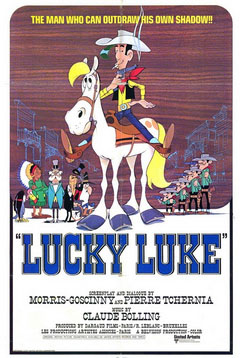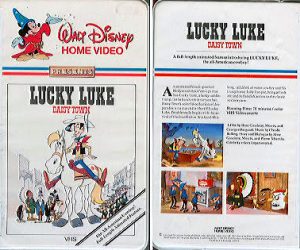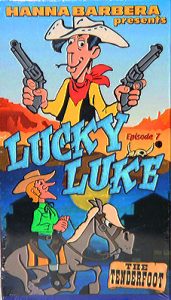A tuneful look at the internationally renowned “poor lonesome cowboy” in his big-screen debut, as well as his connection with the Hanna-Barbera and Walt Disney Studios.

LUCKY LUKE (a.k.a. “Daisy Town”)
Original Motion Picture Soundtrack
United Artists Records UAS-29290 (12” 33 1/3 RPM / Stereo)
Released in 1971 (France, Australia); 1972 (England, Denmark, Sweden, Germany, Spain). Composer/Conductor: Claude Bolling. Engineer: Claude Hermelin. Recorded at Studio Davout, Paris. Running Time: 39 minutes.
Vocalists: Pat Woods, Nicole Croisille, Dan Burke.
Songs: “I’m a Poor Lonesome Cowboy,” “Stamp Your Feet” by Claude Bolling, Jack Fishman; “Daisy Town Saloon Song” by Claude Bolling, Nicole Croisille; “Dalton Theme” by Claude Bolling.
Instrumentals: “Lucky Luke Special,” “Daisy Town Theme,” “The Town Comes to Life,” “The Way West,” “Daisy Town March,” “Duel,” “Far West Choo Choo,” “City Life,” “Battle” by Claude Bolling.
 For over 70 years, Lucky Luke, an affectionate Belgian comic book spoof of the American west, has enjoyed worldwide success. But unlike the Smurfs or the Snorks, Luke never quite lassoed the same huge U.S. following as his Belgian cousins.
For over 70 years, Lucky Luke, an affectionate Belgian comic book spoof of the American west, has enjoyed worldwide success. But unlike the Smurfs or the Snorks, Luke never quite lassoed the same huge U.S. following as his Belgian cousins.
It wasn’t for lack of trying. One of the first attempts was the 1971 English dubbed version of Luke’s first feature, Daisy Town. Retitled Lucky Luke, the film was produced at Belvision, the same studio that produced another film we explored on Animation Spin, Pinocchio in Outer Space.
All the Engligh-speaking voices were impressions of famous stars. Actors using celebrity impressions to create cartoon voices was a longtime technique, such as Larry Storch’s Frank Morgan-like voice for Mr. Whoopie on Tennessee Tuxedo and His Tales for Total TeleVision; Howard Morris using Buddy Hackett as a springboard for Jughead on The Archie Show for Filmation; or John Byner’s take on Dean Martin and Jackie Mason for The Ant and The Aardvark for DePatie-Freleng.
What made Lucky Luke unique that only one actor—impressionist Rich Little–did all the voices for the whole feature (though several vocalists performed the songs). One of the most popular performers of the last 50 years, Little made his debut on The Judy Garland Show after singer Mel Tormé recommended him to the star.
Little became a welcome and frequent presence on TV talk and variety shows, as well as through guest roles on sitcoms. He appeared on stage in Las Vegas and thousands of nightclubs and theaters. He continues to entertain today at the age of 81.
Through Little’s talents, Lucky Luke’s “cast list” includes: Gary Cooper (Lucky Luke), Jimmy Stewart (Narrator), Boris Karloff (Undertaker), Mae West (Saloon Lady), Richard Nixon (The Mayor), Jackie Gleason (Bartender) with Jimmy Cagney, Edward G. Robinson and Humphrey Bogart as Daltons. It was an offscreen showcase that he would later create on-camera in a different way for Canadian television in the 1978 special, Rich Little’s Christmas Carol, broadcast the following year on HBO.
Lucky Luke/Daisy Town was produced as music was in a transitional period and composer Claude Bolling was only too willing to accommodate it by representing a variety of styles. There is the obligatory “Foggy Morning Breakdown”-type piece for the country mood, but also fine jazz, big band and ‘70s-style contemporary background compositions. Sometimes the score fits the time and setting of the period, sometimes it betrays when the film was made, and sometimes there is no reason but fun and whimsy.
 One of the most notable sequences occurs near the beginning, when Daisy Town is constructed, seemingly in minutes. It’s an endless stream of absurd, pure-cartoon gags as this town is manufactured by its citizens. Like a classic UPA cartoon, the scoring is suitably and delightfully odd. (Visually, the film’s design and animation suggests DePatie-Freleng’s theatrical shorts.)
One of the most notable sequences occurs near the beginning, when Daisy Town is constructed, seemingly in minutes. It’s an endless stream of absurd, pure-cartoon gags as this town is manufactured by its citizens. Like a classic UPA cartoon, the scoring is suitably and delightfully odd. (Visually, the film’s design and animation suggests DePatie-Freleng’s theatrical shorts.)
Lucky Luke/Daisy Town was shown in the U.S. on the Disney Channel and was released on VHS by Walt Disney Home Video. This was not unusual as Disney’s video label often licensed outside properties for release under their banner (I Go Pogo and Asterix were other releases), just as Disneyland and Buena Vista Records did successfully with Rankin/Bass, Peanuts and Spielberg properties.
 Three more Lucky Luke animated features followed, as well as live action films (including two starring Italian “spaghetti western” star Terence Hill. The first animated series for television was a co-production by Hanna-Barbera and Dargaud in France, much the same as H-B had partnered with Peyo for Smurfs and Snorks.
Three more Lucky Luke animated features followed, as well as live action films (including two starring Italian “spaghetti western” star Terence Hill. The first animated series for television was a co-production by Hanna-Barbera and Dargaud in France, much the same as H-B had partnered with Peyo for Smurfs and Snorks.
Hanna-Barbera’s 1983 Lucky Luke series was also recorded in French and English. Actor Bill Callaway (Love, American Style, The Hair Bear Bunch) voiced Luke. Another popular impressionist, Fred Travalena, played Jolly, and H-B icons like Frank Welker, Hal Smith and Lennie Weinrib were also in the cast.
In the first episode, Ma Dalton is voiced by Mitzi McCall, who also played Penny Pillar on The Pebbles and Bamm-Bamm Show. With husband Charlie Brill (“The Trouble with Tribbles” episode of Star Trek), she was an early Laugh-In regular and had the historic challenge of having to follow The Beatles on The Ed Sullivan Show!
Have a look at the Hanna Barbera Lucky Luke:
“I’m a Poor Lonesome Cowboy” (End Title) – Pat Woods and Chorus
Also known as the “Lucky Luke Theme,” this song was heard on the end credits of the Hanna-Barbera cartoon. The opening lyrics come from the original comic books, each ending with Luke heading off into the sunset, singing the words.
The movie was also adapted into a French read-along book and record set:


 GREG EHRBAR is a freelance writer/producer for television, advertising, books, theme parks and stage. Greg has worked on content for such studios as Disney, Warner and Universal, with some of Hollywood’s biggest stars. His numerous books include Mouse Tracks: The Story of Walt Disney Records (with Tim Hollis). Visit
GREG EHRBAR is a freelance writer/producer for television, advertising, books, theme parks and stage. Greg has worked on content for such studios as Disney, Warner and Universal, with some of Hollywood’s biggest stars. His numerous books include Mouse Tracks: The Story of Walt Disney Records (with Tim Hollis). Visit 





















































So what would you call a Spaghetti Western made in Belgium? A Waffle Western?
Anyway, I’m powerful obliged to ye, pardner, fer postin’ this here Walloon cartoon. I never heard of “Lucky Luke” and am not surprised that it failed to catch on in the U.S. in the seventies: too much drinking, smoking, violence, panty shots, etc., to be marketed as kiddie fare, and not enough sex, drugs and surrealism to appeal to the Fritz the Cat crowd. For all that, I quite like it; and I’m amused that the outlaws’ horses have appropriate “cutey marks” on their haunches, like characters in My Little Pony.
I’ve long admired Claude Bolling; I once played in a summer concert consisting entirely of his Suites for various solo instruments with jazz combo, which are great fun. But I didn’t know he ever composed for animation. His “Lucky Luke” score covers all the usual musical tropes for Western films, but there are some clever touches — like the way the instrumental breaks become increasingly complex in the square dance scene — that show the hand of a master.
Just one quibble: The title of the famous banjo tune popularised by Earl Scruggs is “Foggy MOUNTAIN Breakdown”, not “Morning”. That kind of mistake’ll get you hauled out to the woodshed right quick in my neck o’ the woods.
In the words of Pinocchio, have a happy dippy-dappy la-la-pa dappy doozy of a day!
Xilam did a Lucky Luke TV series, too. They even did a series focused on the Daltons.
Lucky Luke was quiite known here in Brazil, though not as much as Smurfs. Snorks never really catched up here.
Interesting to learn Brazil was somewhat Snork-less. 😛
There’s also an apparent connection to the series with H-B alum Andy Heyward’s own studio, DiC Productions/Audiovisuel, as that studio’s then-resident music directors, Haim Saban and Shuki Levy, provided the music scores for the series.
Levy and Saban were never DiC only — they always worked and composed in Saban’s own studio in Los Angeles, California. Already in 1983, when DiC entered the US market with Inspector Gadget and The Littles, Levy and Saban were concurrently doing the music for Filmation’s He-Man.